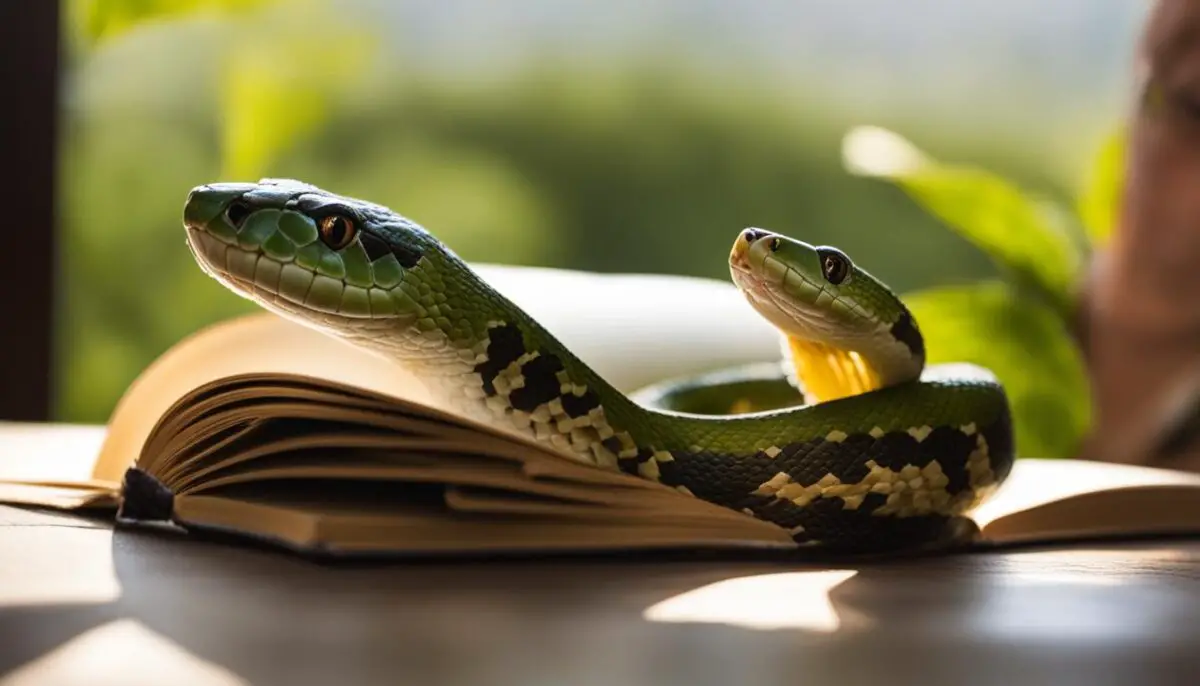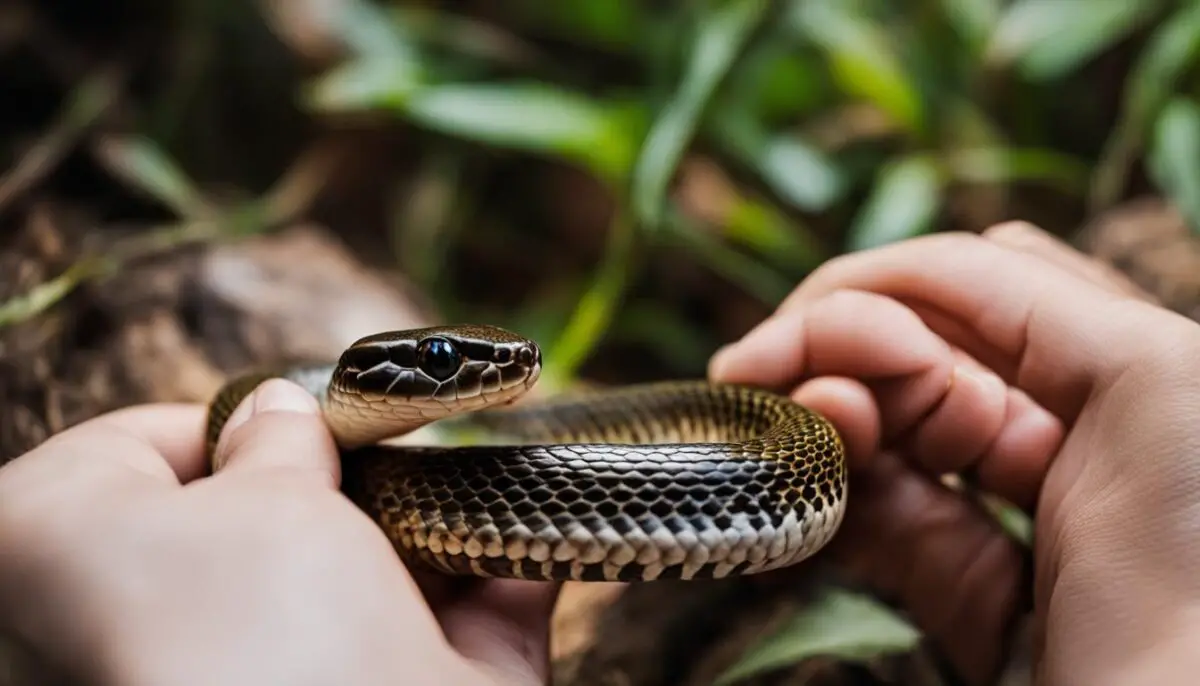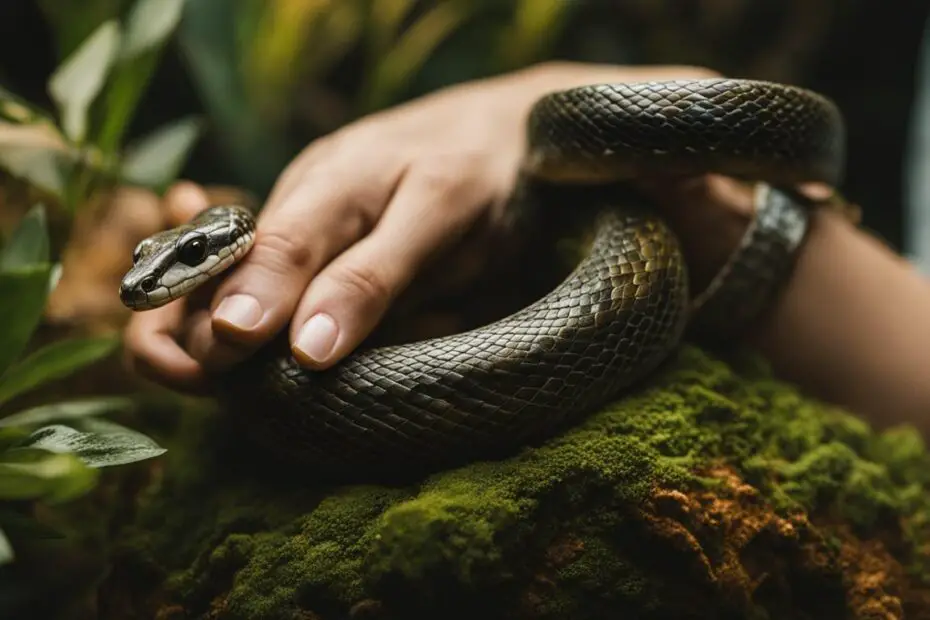Welcome to our exploration of the fascinating bond between snakes and their owners. While snakes have long been regarded as solitary creatures, the idea of them forming affectionate relationships with humans has sparked much debate within the reptile community. Do snakes have the capacity to love? Can they show affection towards their owners? Let’s delve into the truth behind these questions and unravel the unique dynamics of the snake-human relationship.
Key Takeaways:
- Snakes are not capable of experiencing human emotions like love or affection.
- While snakes may develop an affinity for their owners, it is based on familiarity and non-threatening interactions.
- Snakes do not have the cognitive capacity to recognize their owners in a significant way.
- Proper care, handling, and meeting their basic needs contribute to positive snake-human interactions.
- Snakes can make low-maintenance pets, but responsible ownership is crucial for their well-being.
Can Snakes Recognize Their Owners?
While snakes have been known to form familiarity with their owners, the extent to which they can recognize their human counterparts is limited. Unlike mammals, snakes possess weaker and smaller frontal lobes in their brains, affecting their ability to remember and differentiate between individuals.
Snakes primarily rely on their highly developed sense of smell to identify prey and non-prey. Although they can associate their owners with feeding, this is more of a classical conditioning response rather than genuine recognition. Unlike humans, snakes do not strongly link their sense of smell to memory.
Can snakes recognize their owners? No, they do not possess the cognitive capacity for significant recognition.
While snakes may not recognize their owners in the same way that a dog or cat would, they can still develop a level of familiarity and comfort with their regular human interactors. This recognition is more instinctual and based on scent rather than cognitive understanding or emotional attachment.
Understanding these limitations in snake recognition can help snake owners manage their expectations and interact with their pets in a way that prioritizes the unique sensory experiences of these reptiles.
“Snakes are not equipped with the same cognitive abilities as mammals. Their recognition of their owners is more instinctual than cognitive.”
Snake Senses and Memory
Snakes rely on their senses to navigate the world around them, but their senses differ from those of mammals. While snakes possess a keen sense of smell, their sense of smell is not highly connected to memory like it is in humans. This impacts their ability to form recognizing associations with individuals, including their owners.
Furthermore, snakes have limited vision and rely on other sensory cues to perceive their environment. They can detect vibrations, changes in temperature, and even electrical fields to help them navigate and locate prey.
Overall, the combination of limited frontal lobe structure, limited sense of smell-memory connection, and reliance on alternate sensory cues makes it unlikely that snakes can recognize their owners in a way that involves cognitive recognition or emotional attachment.
In summary, snake recognition of their owners is more instinctual than cognitive, primarily based on scent and other sensory cues rather than genuine recognition or emotional attachment.

| Snake Senses | Snake Memory |
|---|---|
| Keen sense of smell | Not strongly tied to memory |
| Poor vision | Limitations in frontal lobe structure |
| Detect vibrations, temperature changes, and electrical fields | Rely on alternate sensory cues for navigation |
Snake Companionship and Care
While snakes may not feel human emotions or form deep attachments, they can still benefit from companionship and care provided by their owners. Creating an environment with proper snake care and understanding their behavioral patterns is essential for fostering positive interactions. Although snakes may not demonstrate emotions like love or affection, they have their own unique ways of showing contentment and comfort.
Understanding snake emotions is crucial in providing the best care and companionship. Snakes thrive in environments that offer warmth, security, and suitable hiding places. While they may not seek out affection in the same way as other pets, they can still appreciate consistent care and a comfortable habitat.
Snakes may not feel love in the same way as humans do, but they can still form a bond of trust and familiarity with their owners. It is important to recognize and respect their individual needs and temperaments.
To provide proper snake care, owners should be familiar with their pet snake’s behavioral patterns. Snakes have specific temperaments and respond differently to various stimuli. Observing their behaviors and body language can help owners better understand their needs and preferences.
| Snake Behavioral Patterns | Description |
|---|---|
| Hiding | Snakes naturally seek hiding spots to feel safe and secure. |
| Basking | Snakes require external heat sources to regulate their body temperature, often seen basking under heat lamps or rocks. |
| Exploring | Some snakes are curious and enjoy exploring their surroundings, especially during their active periods. |
| Feeding | Snakes have feeding patterns and may display excitement when presented with food. |
By understanding snake behavioral patterns and attending to their needs, snake owners can build a stronger bond with their pets. Despite their lack of emotional capacity, snakes can still appreciate the care and attention given to them.
Meeting Basic Needs for Snake Companionship
Meeting the basic needs of a snake is essential for providing companionship and ensuring their well-being:
- Providing a suitable enclosure with appropriate hiding spots
- Maintaining a stable temperature and humidity level in their habitat
- Offering a varied and balanced diet
- Regularly handling and interacting with the snake
These actions contribute to a snake’s overall comfort and contentment, even if they do not display affection in the same way as other pets. Remember, snakes have their own behavioral patterns and ways of showing contentment.

Snake Mating and Family Dynamics
Snakes are generally not social animals and do not form communities, have friends, or nurture their young. However, there are some exceptions. Certain species, like garter snakes, can form friendships with each other. Additionally, sisters of at least one rattlesnake species recognize and prefer each other’s company over that of strangers. These findings suggest that snake behavior is more complex than previously believed, but it is still limited compared to mammals.
While snakes may not exhibit traditional family dynamics or relationships, the ability of some snake species to form friendships and recognize kin indicates a level of social complexity. Understanding snake mating behavior and family dynamics provides insights into their natural behavior patterns and reinforces the importance of maintaining their natural habitats in captivity.
Snakes have unique ways of interacting with each other and their environment. While they may not display affection or nurturing behaviors, their social interactions within their own species can be fascinating to observe.” – Snake Behavior Expert
Snake Mating Behavior
- Snakes engage in various courtship rituals to attract potential mates.
- Mating behavior can include elaborate displays, pheromone signaling, and intricate movements.
- Male snakes often compete for female attention through combat or other forms of competition.
Snake Family Dynamics
- Snake families typically consist of a female and her offspring.
- Female snakes may provide limited care for their young, such as protecting them until they can fend for themselves.
- Some snake species may exhibit communal nesting, where multiple females lay their eggs in a shared location.

While snake mating and family dynamics may not mirror those of mammals, they offer valuable insights into the diverse behaviors and relationships found within the animal kingdom. Understanding the intricacies of snake behavior enhances our appreciation for these unique creatures as we strive to provide them with appropriate care and environments.
Snake Domestication and Longevity
Snakes cannot be domesticated in the same way that other animals can. They are considered captive pets rather than domesticated animals. Snakes have specific care requirements, and understanding their natural instincts is crucial for their well-being.
In captivity, snakes can live longer lives compared to their wild counterparts. Adult snakes have an average lifespan of 20 to 30 years when provided with proper husbandry and care.
| Factor | Wild Snakes | Pet Snakes |
|---|---|---|
| Diet | Varied, hunting in the wild | Controlled, regular feeding |
| Environment | Unpredictable, exposure to predators and harsh conditions | Controlled, appropriate temperature and humidity levels |
| Medical Care | None | Veterinary care, regular checkups |
| Stress Levels | High, constant threat of danger | Low, stable and secure environment |
Proper snake husbandry and care play a vital role in ensuring the longevity of pet snakes. This includes providing suitable enclosures with the right temperature gradients, appropriate substrate, and hiding spots. A balanced diet, regular veterinary checkups, and a stress-free living environment are also essential for their well-being.

Snakes rely on their senses, such as smell and movement, to navigate their surroundings and detect potential threats or prey. While they may show signs of curiosity or react to stimuli, it is important to note that these responses are mainly driven by their survival instincts rather than emotional connection.
Unlike domesticated pets that have been selectively bred for traits such as social behavior or companionship, snakes have evolved to be solitary creatures in the wild. Their biology and natural instincts shape their behavior, making it unlikely for them to develop emotional bonds with humans.
It is essential for snake owners to understand and respect the limitations of the snake-human bond. While they may not seek affection or closeness in the same way as traditional pets, snakes can still provide unique fascination and enjoyment as captivating companions.
“While snakes may not form emotional bonds with humans, their interactions can still be rewarding for both the owner and the snake. It is important to appreciate their innate behaviors and provide a suitable environment that meets their needs.”
By creating a comfortable and secure habitat, ensuring proper care, and respecting their instincts, snake owners can establish a harmonious relationship that allows for observation, curiosity, and appreciation of these fascinating creatures.
Snakes as Pets and Responsible Ownership
Snakes can make great low-maintenance pets, but responsible ownership is essential. While they may not have the same emotional connection as other pets, snakes benefit from regular handling and interaction with their owners. They rely on their owners for proper care, including providing suitable enclosures, feeding, and maintaining their overall well-being. Snake owners should educate themselves on proper snake behavior and handling techniques to ensure a positive and safe relationship with their pets.
Creating a Snake-Friendly Environment
Creating a suitable environment for your pet snake is vital to their well-being. Here are some key considerations:
- Provide an adequate enclosure: Snakes require enclosures that replicate their natural habitat. The enclosure should be escape-proof, properly ventilated, and offer enough space for the snake to move comfortably.
- Maintain appropriate temperatures: Snakes are ectothermic, meaning they rely on external heat sources to regulate their body temperature. A temperature gradient within the enclosure is necessary, with a warm side and a cooler side. Use heating elements like heat mats or ceramic heat emitters to achieve the right temperatures.
- Offer hiding places: Snakes are solitary creatures and need hiding spots in their enclosure where they can retreat and feel secure. Provide a variety of hiding places, such as caves or artificial logs, to cater to your snake’s preference.
- Ensure proper lighting: Snakes require a consistent day-night cycle to regulate their biological functions. Use a light source that mimics a natural day-night cycle, with a period of darkness for rest.
Feeding and Handling Snakes
Feeding and handling practices are crucial aspects of responsible snake ownership:
- Establish a proper feeding schedule: Snakes have specific dietary needs depending on their species. Research and provide a diet consisting of appropriate prey items, such as rodents or insects. Feed your snake on a regular schedule, considering their age and size.
- Handle with care: When handling your snake, be gentle and avoid sudden movements. Support their body properly to prevent injury. Always wash your hands before and after handling your snake to ensure hygiene.
- Respect their boundaries: Snakes have different temperaments, and some may not enjoy frequent handling. Pay attention to your snake’s behavior and body language to determine their comfort level. Avoid handling them during shedding or after a meal.
Education and Continuous Learning
To be a responsible snake owner, it’s essential to educate yourself about snake behavior and husbandry. Stay updated with reputable sources, join online communities, and consult with experienced reptile enthusiasts. Understanding your snake’s natural instincts and behaviors will help you provide appropriate care and establish a positive relationship with your pet.
A Responsible Snake Owner’s Checklist
Use this checklist as a guide to ensure responsible snake ownership:
- Provide a suitable enclosure that meets your snake’s needs.
- Maintain appropriate temperatures and humidity levels.
- Offer hiding places for your snake to feel secure.
- Establish a proper feeding schedule based on your snake’s dietary requirements.
- Handle your snake with care, respecting their boundaries.
- Stay informed about snake behavior and husbandry.
- Regularly assess your snake’s health and seek veterinary care when needed.
By adhering to these responsibilities, you can ensure the well-being of your pet snake and establish a fulfilling and enjoyable relationship with your scaly companion.
Comparison of Common Snake Species for Pet Ownership
| Snake Species | Temperature Requirements | Size | Aggressiveness | Feeding Habits |
|---|---|---|---|---|
| Ball Python | 78-80°F (25-27°C) on warm side, 80-85°F (27-29°C) for basking | 3-5 feet | Mild-tempered | Prey items: mice/rats |
| Corn Snake | 70-85°F (21-29°C) | 3-5 feet | Mild-tempered | Prey items: mice/rats |
| King Snake | 72-80°F (22-27°C) on warm side, 80-85°F (27-29°C) for basking | 3-5 feet | Moderate temperament | Prey items: mice/rats |
Conclusion
While snakes cannot experience human emotions like love, their unique behaviors and interactions with their owners can still create a bond of companionship. Understanding snake behavior and properly meeting their care needs is crucial for responsible ownership.
While snakes may not recognize their owners or demonstrate deep feelings, they can still provide enjoyment and fascination as pets. The key to a successful snake-human relationship lies in respecting the nature of snakes and providing the care and attention they require.
By ensuring a suitable environment, regular interaction, and a proper diet, snake owners can create a positive and enriching experience for both themselves and their pets. While snakes may not reciprocate affection in the same way as mammals, their presence can still bring joy and a sense of wonder to their owners.
FAQ
Can snakes form affectionate bonds with their human owners?
While snakes may not feel human emotions like love or affection, they can feel an affinity for their owners as non-threatening creatures that provide care and handling. They can become accustomed to their presence and develop a familiar association.
Can snakes recognize their owners?
Snakes can associate the scent of their owner as familiar or positive over time. However, they do not have the cognitive capacity to recognize their owners in a significant way like humans do.
Do snakes form deep emotional bonds with their owners?
No, snakes do not form deep emotional bonds or view humans as companions in the same way that other pets like dogs or cats do. Their interactions with humans are primarily instinctual and may not involve the same level of recognition or attachment.
What kind of care and companionship do snakes require?
Snakes thrive in environments with proper care, including providing warmth and hiding places. While they may not demonstrate emotions like love or affection, snakes have their own unique behaviors and temperaments. Understanding snake behavioral patterns and meeting their basic needs can contribute to positive interactions between snakes and their owners.
Do snakes have friendships or social bonds?
Snakes are generally not social animals and do not form communities, have friends, or nurture their young. However, there are some exceptions. Certain species, like garter snakes, can form friendships with each other. Sisters of at least one rattlesnake species recognize and prefer each other’s company over that of strangers.
Can snakes be domesticated?
Snakes cannot be domesticated in the same way that other animals can. They are considered captive pets rather than domesticated animals. Snakes have specific care requirements that must be met for their well-being, as they rely on their basic instincts for survival.
How long do pet snakes live?
In captivity, snakes can live longer lives compared to their wild counterparts, with an average lifespan of 20 to 30 years for adult snakes. Proper husbandry and care play a significant role in ensuring the longevity of pet snakes.
What is the key to a successful snake-human relationship?
Responsible ownership is essential for a successful snake-human relationship. While snakes may not have the same emotional connection as other pets, they benefit from regular handling and interaction with their owners. Snake owners should educate themselves on proper snake behavior and handling techniques to ensure a positive and safe relationship with their pets.

